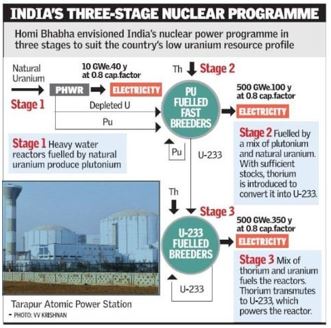

22nd March 2024 (9 Topics)
Context
The recent Nuclear Energy Summit held in Brussels underscores the growing recognition of nuclear power as a critical component in the global effort to combat climate change and achieve sustainable development goals.
1: Dimension- Global Acknowledgment of Nuclear Energy's Role
- COP28 Declaration: The declaration signed by 22 world leaders at the UN Climate Change Conference emphasized the indispensable role of nuclear energy in meeting climate goals.
- Triple Nuclear Energy Capacity: The declaration highlighted the need to triple nuclear energy capacity by 2050 to facilitate the transition towards a low-carbon future.
- Atoms4Netzero Programme: The Nuclear Energy Summit, in collaboration with the IAEA's 'Atoms4Netzero' programme, signifies a multilateral approach to decarbonization.
2: Dimension- Technological Advancements and Financial Considerations
- Innovative Nuclear Technologies: Recent developments in nuclear technology, including Small Modular Reactors (SMRs) and extended fuel cycles, mitigate risks associated with nuclear power.
- Financial Challenges: Despite technological advancements, the nuclear industry faces significant challenges in securing financing from Multilateral Development Banks (MDBs) and private investors.
- Cooperative Funding Models: Successful cooperative funding models in countries like France, South Korea, and Russia demonstrate alternative financing mechanisms for nuclear projects.
3: Dimension- Maximizing Nuclear Energy's Potential
- Public Perception and Education: Addressing public concerns about nuclear safety and radiation risks through public awareness campaigns and education initiatives.
- Regulatory Reforms: Streamlining regulatory processes to expedite project approvals while ensuring safety standards and environmental protection.
- Research and Development: Investing in research and development to enhance nuclear technology, improve safety features, and reduce costs.
4: Dimension- Financial Mobilization and Investment
- Role of Multilateral Institutions: Encouraging MDBs to reassess their nuclear financing policies and explore blended finance models to attract private capital.
- Public-Private Partnerships: Promoting public-private partnerships to share risks and mobilize resources for nuclear projects, thereby diversifying funding sources.
- Incentives and Subsidies: Providing financial incentives and subsidies to incentivize private investments in nuclear energy infrastructure and technology development.
5: Dimension- International Collaboration and Cooperation
- Knowledge Sharing: Facilitating knowledge sharing and technology transfer between countries to accelerate nuclear energy deployment and capacity building.
- Joint Research Initiatives: Collaborating on joint research initiatives to address common challenges, such as waste management, nuclear security, and proliferation concerns.
- Policy Harmonization: Harmonizing international policies and regulatory frameworks to create a conducive environment for nuclear energy development while ensuring global safety and security standards.
|
Small Modular Reactor
|
Mains Practice Question
Discuss the challenges and opportunities associated with nuclear energy expansion in the context of sustainable development goals.




